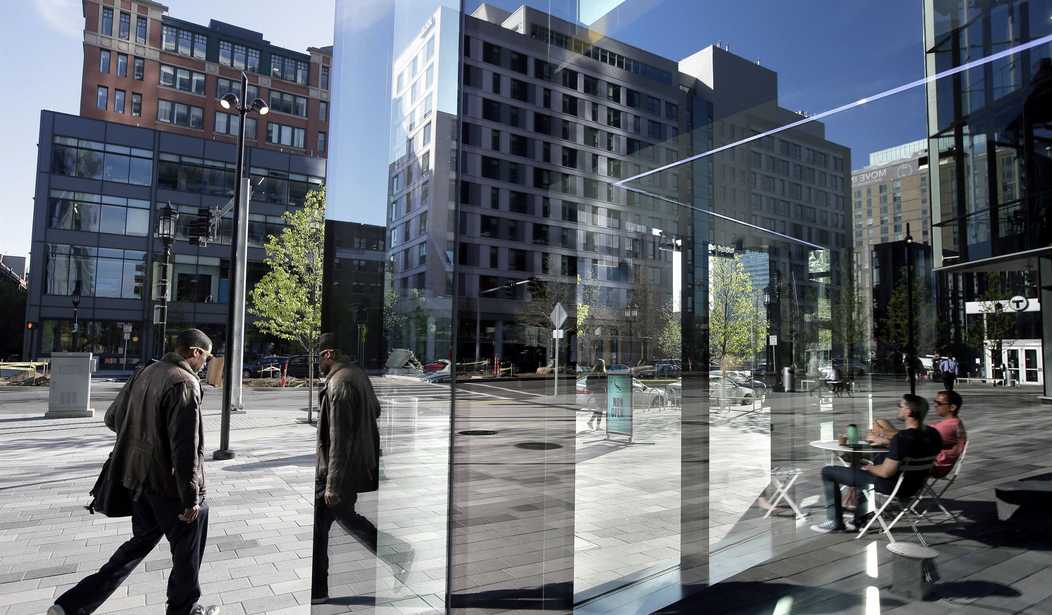The shift back to working in an office vice working from home seems to be picking up steam. As more and more companies/CEOs are reevaluating the benefits of keeping the current status quo in relation to their bottom line and productivity or eye it critically in light of competitive edge, the past few years of staying home look like they may well be on their way out the door, back to the office.
It won’t happen without a fight.
The tug of war over getting workers back to the office just reached a key milestone: 50 percent are back at their desks on average, the most since the pandemic hit in March 2020.
But that means major corporate offices are only half as full as they once were — and many experts think this could be as good as it gets.
Overall growth in office occupancy has begun to level off in recent months despite efforts by many bosses to get workers back more often, according to data tracked by Kastle Systems. Last week, office occupancy across the country’s top 10 metro areas edged up to 50.4 percent of pre-pandemic levels, according to Kastle, which measures office activity through entry swipes.
Indeed, late January marked the first time that all 10 cities tracked by the index — including laggards like San Francisco that lean remote — notched average occupancy rates of at least 40 percent of pre-pandemic levels.
But the return-to-office figures are unlikely to go much higher as flexible work becomes entrenched in the lives of white-collar workers, experts say. Some employees have resisted hard mandates to return: They’ve left for remote opportunities elsewhere or even flouted in-office requirements, flexing worker leverage while the labor market remains hot. In response, more companies seem to be moving toward acknowledging that the 9-to-5, Monday-through-Friday in-office job is over. More than half of U.S. jobs that can be done remotely were hybrid as of November, up from 32 percent in January 2019, according to data from Gallup.
Part of what’s driving the return to the office movement is a return to traditional business models, but part is a trend CEOs and managers have been seeing develop that is worrying for both the bottom line and the future of companies. There simply isn’t as muchwork being done at work, wherever that may physically be.
Employers across the country are worried that workers are getting less done — and there’s evidence they’re right to be spooked.
In the first half of 2022, productivity — the measure of how much output in goods and services an employee can produce in an hour — plunged by the sharpest rate on record going back to 1947, according to data from the Bureau of Labor Statistics.
The productivity plunge is perplexing, because productivity took off to levels not seen in decades when the coronavirus forced an overnight switch to remote work, leading some economists to suggest that the pandemic might spark longer-term growth. It also raises new questions about the shift to hybrid schedules and remote work, as employees have made the case that flexibility helped them work more efficiently. And it comes at a time when “quiet quitting” — doing only what’s expected and no more — is resonating, especially with younger workers.
Citigroup noticed, for one. Even though their CEO was one of the architects of the flex schedule that got these corporations through the COVID crisis, she’s come to realize not every employee was meant to be unsupervised at home. Some people thrive alone and others flounder, lose focus, and become more easily distracted…SQUIRREL! Time for a shake-up in the new order. They’re going to go with a kinder, gentler approach first – bring the laggards in for “coaching.”
When Jane Fraser became CEO of Citigroup nearly two years ago, in the middle of the pandemic, she established the kind of flexible hybrid work culture that’s mostly unheard of among elite Wall Street bankers.
Although Fraser sees no need to return to the old ways, Citi’s experiment has shown not all workers can hack it working remotely. The less productive ones, she said, are being called back into the office for coaching.
“We do measure productivity very carefully,” she said Tuesday during a panel hosted by Bloomberg News during the World Economic Forum in Davos, Switzerland.
…“We do want people collaborating, and they do collaborate better together,” Fraser said. “But at the same time we don’t have to go back to the ’80s model that sort of epitomized Wall Street, either.”
Fraser’s comments do not signal any formal change to the bank’s hybrid work policy, a Citi spokesperson said.
That way they don’t scare everyone and have a general revolt in the ranks as has happened in so many other firms – like the GM white-collar employees’ meltdown I wrote about this past fall.
JP Morgan’s Jamie Dimon is one of the big CEOs pushing to get people back in office chairs.
…Dimon also said there are jobs where remote work is “perfectly reasonable,” like writing a book, or doing research or coding. But he’s still a proponent of returning to the office.
“It doesn’t work for young kids, it doesn’t work for spontaneity, it doesn’t really work for management,” Dimon told Squawkbox of working remote.
And he said that while it might be “OK” to have remote or hybrid workers in some jobs, it also “better be okay for the company, the clients, not just the individual.”
JPMorgan has asked half of its employees to go back to the office full time, and 40% of employees to go in at least a few days of the week. Last April, it came to light that the company was tracking employee attendance using their ID swipes.
Along with leaders of other corporations who have put their employees on notice about the numbered days of remote working, he’s focused on the company, the clients it serves, and it’s mission. The company is not there to serve the employees’ needs.
…Dimon isn’t alone in his assessment. Morgan Stanley CEO James Gorman this month said he wants employees back in the office at least three or four days a week. Citadel CEO Ken Griffin slammed remote work at a conference last year, saying innovation and creativity declines because of it.
But it sure seems as if opinions among employees and some business analysts are more concerned with the feelings and diversity quotas rather than operations.
…But the push from some CEOs to return to the office could come at a cost to workforce diversity — something these and other chiefs have vowed to increase. Working from home doesn’t only help women who are caregivers, it can be life-changing for some people from underrepresented backgrounds. Remote work has opened career opportunities for many with invisible disabilities like depression or ADHD and those with physical disabilities. It’s also improved working conditions for some Black workers and some male caregivers.
…Some Black workers report facing less discrimination and fewer microaggressions working from home than when they’re at the office.
“I do not foresee myself ever returning to an office,” Leron Barton, a writer who describes himself as someone with two decades of experience in corporate America, wrote in a Slate essay titled “I’m Black. Remote Work Has Been Great for My Mental Health.”
McKinsey & Co. reported in April that people from marginalized communities were more likely to prefer and stay at jobs that offer remote or hybrid-work setups. Black employees were 14% more likely than their white counterparts to say they would leave a job if remote work was not available, the consultancy said. LGBTQ employees, meanwhile, were 24% more likely to leave than their heterosexuals peers.
That’s a heckuva survey result. *blinkblink* And I would not want to be any part of the HR department in any of those places. The drama quotient has to be over the top.
Then there are the dolts who figured things were set in stone and they’d never have to set foot in the office again, never, ever, ever. So they up and moved.
Jamie Sexton was one of the many people who took advantage of remote working by moving from the pricier state where her job was located to a more affordable area.
Sexton, 44, works as a pharmacist for a healthcare provider in San Diego. She was paying $4,000 a month to rent a two-bedroom home in La Jolla, a coastal suburb 20 minutes north of downtown San Diego.
She didn’t think she could afford to buy in San Diego, where homes cost $900,000. So, under the impression she could work remotely forever, she opted to conduct her house hunt in Oregon’s capital city, Salem.
…But in January of 2023, her job called her back to California.
Her job didn’t “call her back,” for crying out loud. She never bothered to find out if she could leave. There’s a huge difference.
In fairness, there are some working moms who are having to make tough choices about those careers and the pandemic lives they lived that they really don’t want to face. It turns out they enjoyed taking care of their kids when they had time.
…Without the burden of a commute, we did our jobs, took care of our kids, and sometimes even got to exercise. Being able to pull it off was dependent on having reliable childcare—a big “if”—but, for many people, remote work meant the difference between chaos and sanity. One recent study found that it saved people like me an average of 72 minutes a day.
…And that lawyer in Chicago with her three bonuses? She was told to start commuting three times a week in 2023. Now she’s talking to a recruiter to find a new job that will allow her to work remotely, even though she knows it will be a “step down” in prestige and pay.
“The pandemic gave me a taste of what my life could be like—I could get excellent reviews at work and still felt like I’m being a good mom,” said the woman, who didn’t want her name used because she is still looking for a new job. “Why are we trying to push so hard to go back to this previous reality that wasn’t working so well?”
It only “wasn’t working so well” for you. An employer is exactly that. He’s not a babysitter – he pays a salary for your time and effort and has every right to expect you to hold up your end of the bargain you agreed to.
It’s going to be a rude adjustment for many people. It also may be an untenable situation for many, because of childcare difficulties, etc.
But it was truly unrealistic to believe the situation was going to continue forever.








Join the conversation as a VIP Member